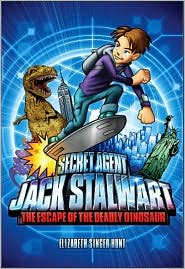As I looked ahead at the story elements unit, I realized that I had to do some work on making inferences. After all, telling kids to make inferences about the setting of a story won't make much sense if students don't know how to infer!
But where to begin? With this group of readers, I want some quick success to build their confidence. I decided to start with text-based inferences, taught along with some visualizing. As I wrote about in The Forest and the Trees, text-based inferences are those that depend on a knowledge of how text works. Finding the speaker in dialogue, matching pronouns with antecedents, and using specific clues from a text are all examples of text-based inferences.
Visualizing, on the other hand, is a form of reader-based inference, which depends on a reader's background knowledge. Why is visualizing a form of inference? No author ever tells every detail about a passage. Instead, a reader needs to bring some background knowledge to the text in order to form a visual image.
Critical Facts and Rules
As I researched The Forest and the Trees, I came across an interesting journal article. This article, authored by Philip Winne, Lorraine Graham, and Leone Prock, explains how struggling readers learned to make text-based inferences with the help of some carefully written texts and immediate feedback. The study is on the older side (1993), but I couldn't help but see how the methods described could help my students. Readers don't need a whole lot of background knowledge to make these inferences. And the process forces them to look closely at the details in the text to explain how they make their inferences. Great stuff for my students!
Sadly, the journal article only included one example text. So I wrote a set of my own texts to use with students next week. I chose a spy theme, since the Jack Stalwart books are popular with my readers right now. (If you haven't read these books, they are lots of fun for transitional readers--great gadgets and action, all in a supportive text.)
The texts that I wrote (on a sunny Saturday, when I should have been doing math plans) set readers up to make text-based inferences. A rule is presented early in the text. Then, the character is faced with choices, along with a good deal of distracting information and a hidden critical fact. The reader needs to match the rule with the critical fact to make an inference.
I plan to teach Mission #1 on the whiteboard, showing students how to make the inference using the rule and the critical fact from the text. Then, they'll work on Missions 2 and 3 with a partner, with a lot of supervision. Finally, they'll work on Mission 4 on their own.
This kind of inferencing is a great first step for transitional readers. Once students get good at finding these text-based inferences, they'll be ready for the next step into more open, reader-based inferences. And--hopefully--ready to have some brilliant discussions about finding the setting in a story!
If you try these mission files with your class, I'd love to hear how they work!


What a great activity for teaching inferences. When it comes to my English language learners, inferencing and drawing conclusions are difficult skills, both for me to teach and for them to learn. I'm always on the lookout for great ideas! Thanks for sharing.
ReplyDeleteLaurah